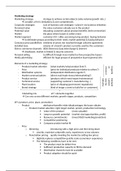Marketing strategy
Marketing strategy strategy to achieve certain objects (sales volume/growth rate..)
consider a firm’s limitations & core competencies
Corporate strategies sum of business unit strategies + plans fr nw business initiatives
Perceived value the value customers already see in the product
Potential value educating customers about product benefits (mrkt cmmnction)
Market the place where buyers & sellers meet
Market segment customers tht r alike: perceivng/using product, buying behavior
to delineate groups according to their need, market potential & buying behavior
Conscious price parallellism similarity of prices not reached through collusive agreement
Installed base volume of a brand’s product currently used by the customers
Elctrnc commerce channels (EDI) Electronic Data Interchange & internet
drawbacks: market is limited & security concerns
Personal selling to difficult through mass media/too few prospective buyers
Media advertising efficient for huge groups of prospective buyers/general info
Elements of a marketing strategy:
- Product/market selection (what markets/what product lines?)
element
nt
Importa
- Price (price for individual products/relative to others?)
- Distribution systems (independent distributors/agents?)
- Market communications (direct mail/trade shows/telemarketing?)
- Product service (products which need repair/maintenance)
industry
vary by
s which
Element
- Technnical service (supporting customer’s manufacturing…)
- Plant location (price of shipping/government regulations)
- Brand strategy (kind of image u want to build for ur customers)
Marketing mix all ^ elements together
Can vary across different markets, growth stages, products, competitors
4P’s (product, price, place, promotion)
- Product attributes+benefits+risks+disadvantages the buyer obtains
o Product/market selection: right target market, prodct, production technology
Value of the product (most valuable)
Long-run growth potential (market size/opportunities, profit)
Resource commitments (invest R&D/marketing/prodction)
Competitive positioning
Company-prodct/market fit
- Price
o Skimming introducing with a high price and then bring down
Lowrisk, maximize unitprofits early, experiences w low volumes
o Penetration pricing quickly invading the market by setting low prices
Highrisk,replaces competition,quickly scale economies+ experience
The following conditions have to be met:
The product must be defect-free
Sufficient production capacity to fill the demand
Distribution channels must be available
Product adaption should be quick
, Price is affected by 5 factors:
o Supply/demand (high spply=low prices/high demand=high prices)
o Production & overhead costs
Efficient manufacturing/distribution & achieving scale economies
o Competition (price pressures)
Product differentiation (monopoly because unique prdct)
Dampen intrabrand competition among resellers
Exercising price leadership (power to set price levels)
o Buyer bargaining power = able to put downward pressures on price:
If the buyer group forms a major amount of the company’s sales
Improve power: differentiating their products
If the buyer has several options to choose from
Won’t happen if the customer is satisfied with ur product
o Product value to potential customers (most important)
Price the product to the value of the product given by customers
Perceived consumer value differs across market segments
only successful combined wth functional product differentiation
otherwise: black-market phenomenon
- Place (distribution channels)
o
Installed base
Market share leadership
Product Channels
superiority strength
o Direct sales reps employees that call directly on its customers
Big amount,extensive prodct service,technical support, customization
o Sales agents independnt operatrs, carry the lines of several suppliers
Same as direct sales reps + represent variable cost (commission)
o Distributors buy from many suppliers & have wide product lines
Small amount of different items + ready & reliable availability
o Retail dealers large infrastructure supplies end-products to consumers
Some are franchised
Conform to store design, service quality, product presentation
wrkng w intermediaries: prdcts r stocked/display properly/prices don’t deteriorate
factors that gain strength
Selective distribution instead of intensive distribution
Superior breadth & quality of the product line
High supplier-reseller-interdependency
Supplier’s own saleforce present in resale level
End-market demand development
- Promotion (Market communications)
o Successful use of channel (telemarketing, third-party influencers, television)
, Decision-making-unit (DMU)
Decision-making-process (DMP)
Awareness (television & print advertising)
Information (visiting stores & talking w friends)
Identification options
Source qualification & short listing
Selection (salesperson)
Post-purchase affirmation
o Push-strategy = pushing the product to end-users
Clerk’s recommendations, resalers after-sale service, presentation
o Pull-strategy = creating end-market demand
Meaningful brandname, effectively communicating product benefits
Market segmentation by variables:
1. Demographic segmentation (age,sex,income,ethnicity / size,nature,industry type)
2. Geographical segmentation (market potential,competitive intensity,shipping price)
3. Psychographc sgemntation (lifestyle,attitudes towrd work/home+corporate culture)
4. Product use/application (how the product will be used/applied)
Marketing Myopia
- A too narrow industry definition sets restrictions to managerial thinking & strategy
formulation & can lead to the loss of customers & the extinction of the company.
- Be customer-oriented instead of product-oriented
constantly looking for opportunities to apply their technical know-how to the creation
of customer-satisfying uses that account for the output of successful new products
- The self-deceiving cycle of bountiful expansion & undetected decay (4 conditions)
o Population myth
Assumption that profits are secured by the population growth
Lead to a lack of innovation (competitor gains advantage)
o Lack of perceived and credible substitutes for the industry’s major product
Believe there is no competitive substitute
Blinded from accepting other alternative products
o Faith in mass production & the benefits of reducing unt costs as output rises
Leads to an emphasis on selling the product instead of marketing it
Product-oriented instead of customer-oriented
prevents from the prodct to adapt to changing customer tastes
o Risk involved in R&D
Being too focused on product/price reductions
- The company as a whole must exist in order to create value for customers
Strategic insight in three circles




